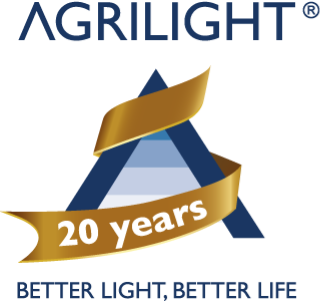Dairy cattle cannot distinguish between high pressure sodium and metal halide, so only the intensity and duration of the light are important. Research has shown that the minimum light level should be 150 lux. A lighting regime of 16 hours of light at a minimum of 150 lux in dairy farms, followed by 8 hours of darkness (maximum 5 lux) will produce the positive benefits mentioned above. Using the lighting to increase the day length affects melatonin production. Melatonin is also known as the sleep hormone. Light inhibits melatonin production and darkness accelerates it. In other words, longer periods of light mean less sleep hormone and healthier, more active cows. The lighting regime in dairy farms described above simulates long summer days, the days when the cow is naturally most active, resulting in higher yields and higher feed intake.
It is important to realise that independent research into the effects of lighting on dairy cattle has been carried out since 1978. It has shown that the correct light intensity and duration have a very positive effect on the health, fertility, welfare and productivity of dairy cattle. Probably the best known phenomenon of light is that it controls hormone levels in dairy cattle and therefore has a positive impact on milk yield, which can increase by 15%. It is probably less well known that correct, uniform lighting in livestock housing improves fertility and has a positive influence on oestrus, and also makes it easier to spot. The calving interval can also be reduced by using the correct lighting regime and light levels. Signs of disease can also be detected at an earlier stage. In other words: the correct lighting will ensure that livestock are healthy and active.
- Up to 15% more milk
- Improved fertility
- Better heat detection
- Reduced calving interval
- Better disease detection
Lighting regime for dairy cattle
- 16 hours of light – 8 hours of darkness
- Light intensity 150 – 200 lux
Red light is the most suitable light source to use as night lighting when the dairy farmer has to be in the barn during the dark period. This is the conclusion of, among others, Livestock Research of Wageningen University and the Leiden University Medical Center from research*.
The (monochromatic) red light is the most ideal light source to use as night lighting in the barn during the inspection round or activities of the dairy farmer, because with this light color the biorhythm of the cow is disturbed the least.
In addition, Agrilight has many years of experience with the use of red light as ‘night light’ in the barn, with many positive reactions from livestock farmers.
* Title: “The effect of light color and light duration on milk production and behavior of dairy cattle”. Report 652, Nov. 2012.
In summary, a regime of 16 hours of light at a level of 150 to 200 lux followed by 8 hours of darkness produces the following results in dairy cows:
• Up to 15% more milk
• Improved fertility
• Better oestrus detection
• Shorter calving intervals
• Better disease detection
Young stock
Young stock are the dairy cattle of the future, so why not treat them the same? The right light level in young livestock housing with the right lighting regime have the following positive effects on young cattle:
- Improved body growth
- Faster onset of puberty
- Higher feed intake
- Positive influence on udder development
The recommended lighting regime for young stock pens is: 16 hours of light – 8 hours of darkness, light intensity: 150-200 lux
Dry cows
In preparation for the new lactation period, it is important to dry off cows. The right light level with the right lighting regime have the following positive effects on dry cattle:
- Higher milk yield in the next lactation (+3.2 kg)*
- Lower prolactin levels in milk*
*source: Light further exposed (WUR)
Placing dry cows in the light regime of 16 hours of light and 8 hours of darkness a few days before calving promoted higher feed intake before calving. It also allows the cows to get used to the higher light level.
The recommended lighting regime for dry cows is: 8 hours of light – 16 hours of darkness, light intensity: 50 lux
An unsuitable light level or lighting regime may have implications for the health, performance and welfare of your livestock. That’s why you should always seek advice before purchasing lighting for your livestock housing. We can draw up a free, no-obligation lighting plan that will set out all the benefits of a good, well-designed light level.





